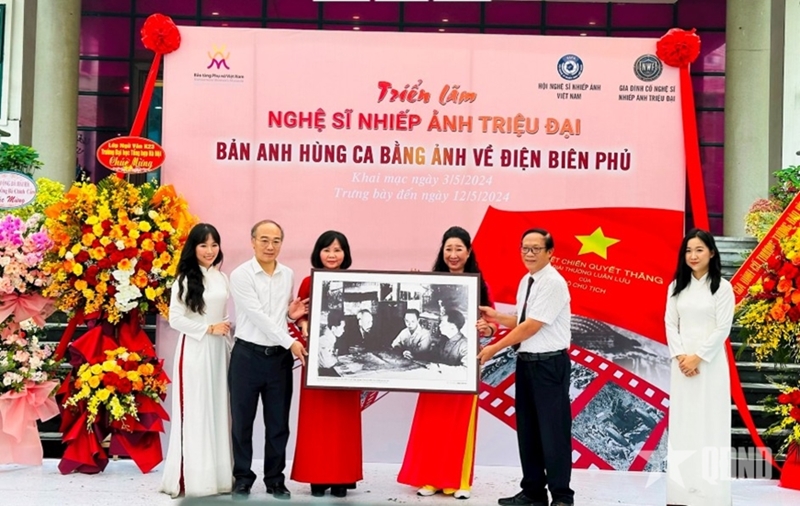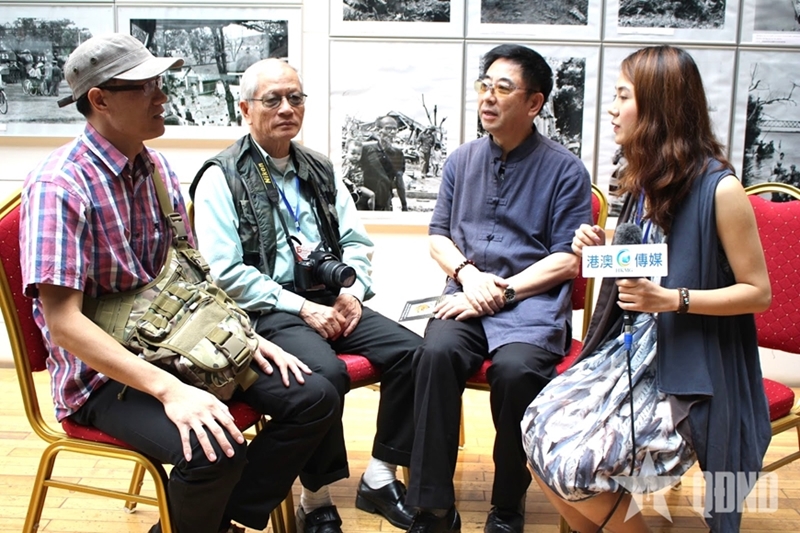Among them were legendary names that became part of Vietnam’s revolutionary photography history. They were Trieu Dai, Nguyen Dinh Uu, Dinh Ngoc Thong, Vu Ba, and Doan Cong Tinh. Five individuals, five different fates, five unique journeys but all shared the same mission of standing tall on the front lines to record the feats-of-arm of our troops and people, and the crimes of the enemy.
Moments forever linked with Dien Bien Phu
In the early days, photojournalists of the newspaper had to take pictures and develop their films, only to store them away “in the archives.” During the resistance war against the French colonialists, they faced constant hardships such as moving from place to place, even burying their printing equipment before enemy raids. Having images printed on newspaper pages at that time was an enormous challenge.
In such conditions, photographer Trieu Dai (1920-1992) still firmly held his camera, trekking through bomb storms, mountains, and muddy trails to capture historical moments of our troops and people during the Dien Bien Phu Campaign.
    |
 |
|
The family of photographer Trieu Dai presents one of his valuable photos to the Vietnam Women’s Museum. |
His photographs, depicting President Ho Chi Minh discussing the opening of the campaign, soldiers hauling artillery into designated position, and French prisoners being escorted through Muong Phang, have become symbols of Vietnam’s 20th-century history. His photo series entitled “Dien Bien Phu Victory 1954” was not only an invaluable historical documentation but also a powerful weapon on the diplomatic front, affirming the justice of the Vietnamese people before international friends. For his remarkable contributions, Trieu Dai was honored with the State Prize for Literature and Arts (Photography category) in 2001.
Also present at Dien Bien Phu Theater was photojournalist Dinh Ngoc Thong (1930-2002), who offered another emotional angle on the war. His iconic photograph “Soldiers at Dien Bien Phu reading letters from home in the trenches” has moved generations of viewers. Amidst the smoke of battle, the rare moment of serenity with the joy shining in a soldier’s eyes as he read letters from home spoke volumes about the spirit of our troops and people. The photo earned the State Prize for Literature and Arts in 2007, a testament to the compassion and sensitivity of a soldier-journalist.
Although never formally trained in photography, Nguyen Dinh Uu (1918-2001), a member of Division 308, entered the craft through passion and relentless self-learning. In 1951, he was assigned to work at PAN and became a close companion to soldiers. His photos were simple yet profound, full of life.
On October 10, 1954, amidst jubilant crowds celebrating the liberation of Hanoi, Nguyen Dinh Uu captured a historic moment of “French expeditionary troops withdrawing from Hang Dau police post.” In the photo, Unce Ho’s soldiers stood proudly at the center, while French troops bow their heads on both sides, a natural yet powerful composition. The work, together with his photo “Female militia personnel”, earned him the State Prize for Literature and Arts in 2001.
Working between life and death
Among generations of photographers during the resistance war against the U.S. imperialists, Vu Ba (1930-2018), whose real name was Tran Phu Hanh, stood out as one of the most renowned. Having worked at PAN for many years, he was remembered by his colleagues as a person having a “divine eye” for war photography.
The story behind his photo “Phuc Tan calls for revenge” has become a legend in Vietnam’s journalism circles. On May 17, 1966, when air-raid sirens wailed over Hanoi announcing an American bombing attack in the North, Vu Ba rushed out of the newsroom, pedaling through bombs to reach the Phuc Tan area. In the middle of the smoke, he captured a heart-wrenching image of a little girl running and crying. That photo laid bare the cruelty of war and awakened a deep resistance spirit in every viewer.
Even his pen name Vu Ba reflected his bravery. He once explained: “I joined the revolution early. I was always ready to be captured by the enemy, so I chose the name Ba (meaning ‘Father’ in Vietnamese). That way, if they tortured me and shouted ‘Ba!’, at least I’d enjoy hearing it.”
While Trieu Dai, Dinh Ngoc Thong, and Nguyen Dinh Uu were witnesses to Dien Bien Phu, Doan Cong Tinh (born in 1943) became known as “the eye of Quang Tri ancient citadel.” He was the only photojournalist who was allowed to enter the ancient citadel during the 81 fierce days and nights of 1972. His works, “Smiles beside Quang Tri ancient citadel,” “On the nameless hill,” and “Seizing Dau Mau base,” captured the most authentic moments of the war. In 2007, these three photos earned him the State Prize for Literature and Arts, recognizing the immense bravery of a photographer who constantly worked on the edge of life and death.
    |
 |
|
Photographer Doan Cong Tinh (second from left) in an exchange with foreign journalists |
Capturing with courage
The history of the People’s Army Newspaper records that its war photographers did not merely take pictures, they lived within their own frames. They carried their cameras through bombs and bullets, capturing with faith and courage. Some never returned.
One of them was Hero of the People’s Armed Forces, martyr, and journalist Le Dinh Du whose pen name was Ho Thua. In 1968, in the Gio Linh front in Quang Tri, during a fierce battle, when told to stay low in the trench to avoid enemy fire, he replied: “A soldier can shoot standing, kneeling, or lying down. But a journalist must stand tall on the trench, using his weapons, the camera and the pen, to record the victories of comrades and the crimes of the enemy.” He fell at that very moment, standing upright, camera in hand, immortalizing the bravery of our soldiers in the face of enemy assaults.
Each photo taken by PAN’s war photographers is a piece of history, a “witness” telling future generations about the courage, resilience, and sacrifices of Vietnamese troops and people in the struggle for national independence and defense.
As photographer Ho Sy Minh, Permanent Vice President of the Vietnam Association of Photographic Artists and Editor-in-Chief of Photography and Life magazine, affirmed: “Many PAN’s photographers laid down their lives, leaving behind a priceless archive of photos for the nation. These photos of war possess immense communicative power, helping people better understand the reality of war, the value of peace, and the great contributions of troops, raising awareness of safeguarding national sovereignty. Their works have become part of our national heritage, preserving war memories and educating today and future generations. In every era, PAN has had outstanding photographers whose contributions have deeply enriched Vietnamese photography.”
Translated by Mai Huong